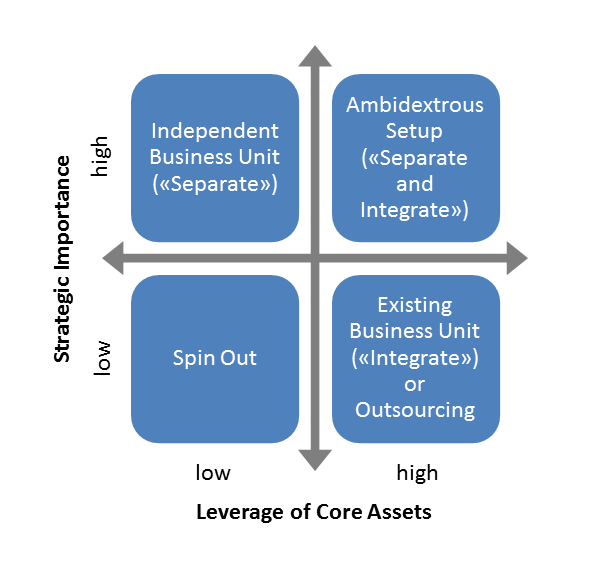Probably the most critical structural ingredient for innovation capability is how new ventures – internal as well as external ones – are to be implemented in the organization in order to get validated and scaled. Should a new venture be entirely separated from the core business as stand-alone venture? Should it be integrated into an existing business unit? Or is it indicated to balance separation and integration by implementing an ambidextrous organizational setup? In many organizations, no appropriate guidelines for this issue have been given up to now, although this poses a necessary condition to dual, integrative innovation success.
In the following a framework is suggested, drawing on the recent work of Charles O’Reilly and Michael Tushman. The underlying matrix is spanned by determining two criteria:
- What’s the venture’s strategic importance for the company? Strategically important ventures mostly address a company’s growth or future business and can be assigned to H2 or H3 in the innovation portfolio.
- Can the innovation venture leverage existing firm assets to gain competitive advantage? Those assets mainly consist of competencies, customer base, sales and marketing channels, manufacturing, technology platforms or brands.
Depending on the innovation venture’s particular characteristics, four quadrants can be considered:
Neither strategically important nor operationally related: In this case, it is recommended to spin out the venture within the larger company or to the public.
Operationally related but not strategically important: Under these conditions, the venture can be integrated into an existing business unit or contracted out, depending on the value to the company. For example, many incremental innovations or improvements within H1 (such as service or process innovations for existing products) may be operationally related to and even required for the existing business. However, they are not deemed to be strategically relevant for long term success. The choice is to cover them internally or rely on a partner in order to free up resources for strategically relevant ventures.
Strategically important but no leverage from core assets and capabilities: In this case, the new venture should be implemented as an independent business unit. This often occurs in case of disruptive (competence-destroying) ventures and when entirely new and different technologies, business models and capabilities are required to build the business, respectively.
Strategically important and able to leverage core assets and capabilities: This is the case of competence-enhancing, explorative innovations where an ambidextrous organizational design, building upon a dedicated exploration unit, is required. To strictly separate the new venture from the core would risk to sacrifice the future by not drawing on existing competencies and resources. Upon given fit with core (sustaining innovation), the venture is eventually going to be transitioned after a critical size. Therefore, a careful balance of independence and connection is needed here to maximize likelihood for success. Another case addresses strategic adaptation of existing core business by partially renewing the existing business model or applying new technological capabilities. As these innovation ventures are primarily driven out of the existing business units, a sufficient degree of separation to the operational business, e.g. through dedicated teams, labs or startup accelerators, needs to be ensured at the outset.
Takeaway
Strategically important innovation ventures – mostly located in H3 (future business) or H2 (growth business) – usually demand a high degree of or even complete separation from the core business. If competitive advantage can be gained from leveraging existing firm assets, a proper balance with integration in the core is crucial. Existing assets and capabilities can be considered the main advantage of large companies in their competition with nimble startups and cross-industy competitors in the face of accelerating disruption and industry convergence.
Consequently, the following combination is key for established companies to stay ahead:
- Selection of strategic internal and external innovation ventures that draw on existing assets and capabilities
- Proper implementation of appropriate dual corporate innovation structures and approaches to tap this individual competitive advantage

5 Responses to Corporate Innovation Ventures: Separation vs. Integration